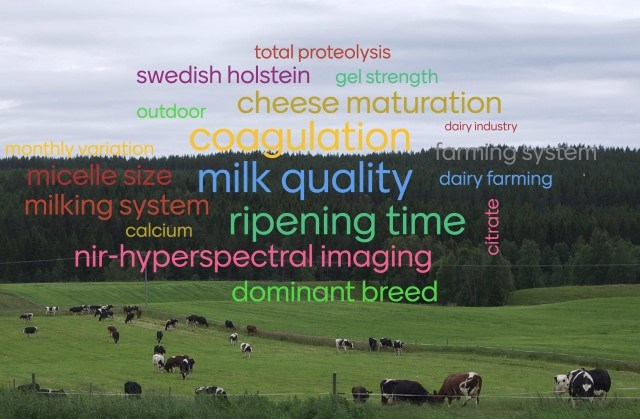Factors behind variation in raw milk quality and its impact on cheese making properties

Close monitoring of raw milk quality is vital, as high quality in the final product can only be achieved using high-quality raw milk. Hence, approaches to characterise the raw milk, factors influencing the quality of milk and the association with final product characteristics are of great interest. A group of researchers from SLU (Uppsala and Umeå), a dairy factory in northern Sweden and a dairy farm advisory organisation investigated causes behind observed variation in the ripening time of a traditional long-ripening Swedish cheese. The aim was to evaluate the variation in raw milk quality, reasons for its variation and how it influenced the ripening time of the resulting long-ripening cheese. For this purpose, the composition and properties of milk from participating dairy farms, used for cheese making by the dairy partner in this project, were evaluated, to determine the influence of various factors on dairy farms and the influence of season or month. The cheeses produced from the milk were then monitored until they acquired the characteristic flavours and texture defining their ripening time.
Since raw milk quality is of great importance in cheese making, an experiment was conducted to examine the effects of three selected milk quality parameters (casein micelle size, calcium content and citrate content), and their interactive effects, on milk coagulation, which is the first step in cheese making. Work was also carried out to develop a predictive tool for rapid monitoring of cheese maturation without having to destroy the cheese wheel. For this purpose, an image analysis technique, near-infrared hyperspectral (NIR-HS) imaging was applied. This technique can be used to relate the NIR spectrum of a sample with pixels in the image, by applying predictive models using advanced statistical methods.
In industrial cheese making, calcium is added to the cheese milk and this will most likely induce interactions with citrate and casein micelles. The research group found that casein micelle size and citrate content interacted, influencing the resulting gel strength. Larger micelles with moderate citrate levels resulted in the formation of a firmer gel than small micelles with higher citrate levels. Field studies showed that casein micelle size was subject to seasonal variation, with smaller micelles during the summer months. Total proteolysis in farm milk showed higher values during the summer compared with the rest of the year. Dairy silo milk quality was also subject to monthly variation. Cheese ripening time showed a weak association with all milk quality parameters studied, but the sensory and texture scores of the cheeses were affected by the activity of plasmin and plasminogen in the silo milk. This illustrates the important role of the native proteolytic system in milk for the ripening of this Swedish long-ripening cheese. An impact of the milking system and dominant breed on-farm on milk quality attributes was demonstrated. Two major types of dairy farms were distinguished in the study region: (I) smaller tiestall farms with cows of Swedish Red Cattle and multiple other breed types and (II) larger farms with loose-housing, milking parlour or automatic milking and Swedish Holstein as the dominant breed. These dairy farm types resulted in milk that differed in composition and properties, with e.g., higher fat and protein content and lower cell count in milk from type I farms. Predicting and monitoring the cheese ripening process is crucial for the cheese industry, and for this, the use of non-invasive techniques is of great interest. Use of NIR-HS images in predicting and understanding the variation in cheese maturation (age-related) through visualising the maturity of cheeses was tested. The model developed achieved 76% accuracy in prediction of maturity and made it possible to visualise variation in cheese maturation both within and between cheeses. Cheese maturation was initiated in the core of the cheese wheel and then spread to the periphery. Variation in maturation also observed among cheeses within a batch.
Summing up, this work demonstrated that raw milk quality in northern Sweden varies with farm type and month and that the monthly variation is reflected at dairy silo level. However, the monthly variation in raw milk quality was not linked to observed variations in cheese ripening time, suggesting that factors not covered in this study, e.g., processing parameters, are of greater importance. Thus, when the raw milk is of high quality, as it was in this study, the development of aroma and texture, which governs the cheese ripening time, is not influenced by the variation in raw milk quality parameters. Consequently, approaches to differentiate raw milk based on quality parameters when producing this specific traditional Swedish cheese might provide very little economic benefit. This research provided multiple insights on variations in raw milk quality and factors, which can influence cheese quality. It also raised many questions to be addressed in future work, such as identifying major causative factors for the variation in ripening time. The results obtained to date can be valuable in future studies working to solve the challenge of variation in cheese ripening time and increase the sustainability of cheese production.
Reproduced from Priyashantha, H. (2021). Variation in raw milk quality: Impact on milk coagulation and cheese ripening (Doctoral Thesis 2021:48, Swedish University of Agricultural Sciences). Acta Universitatis Agriculturae Sueciae. ISBN: 9789177607748.
Link to the full thesis (Open Access): https://publications.slu.se/?file=publ/show&id=112919